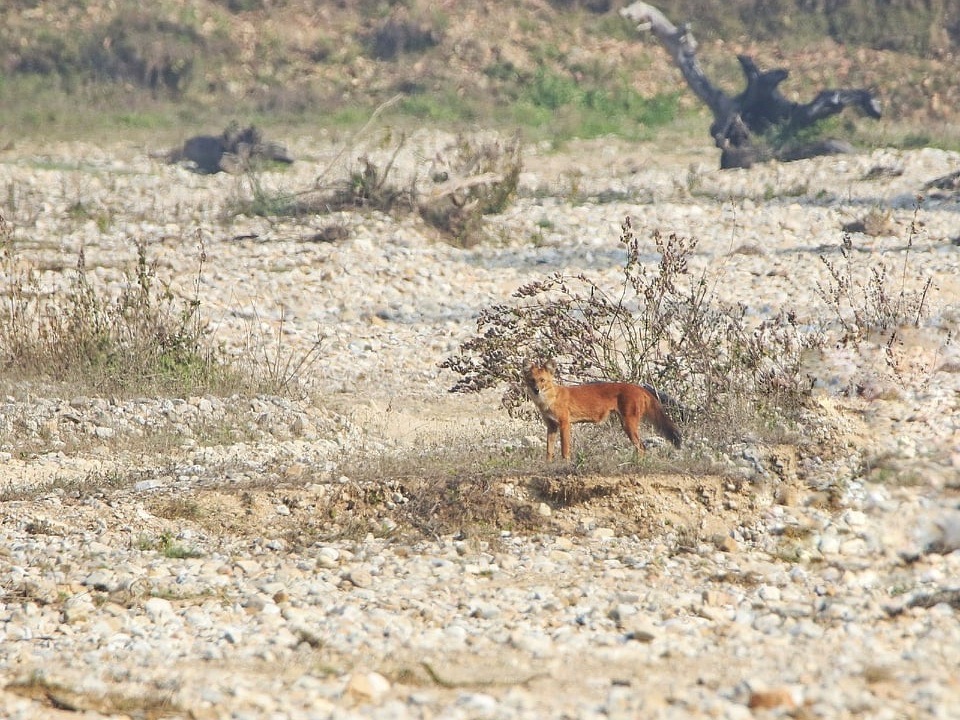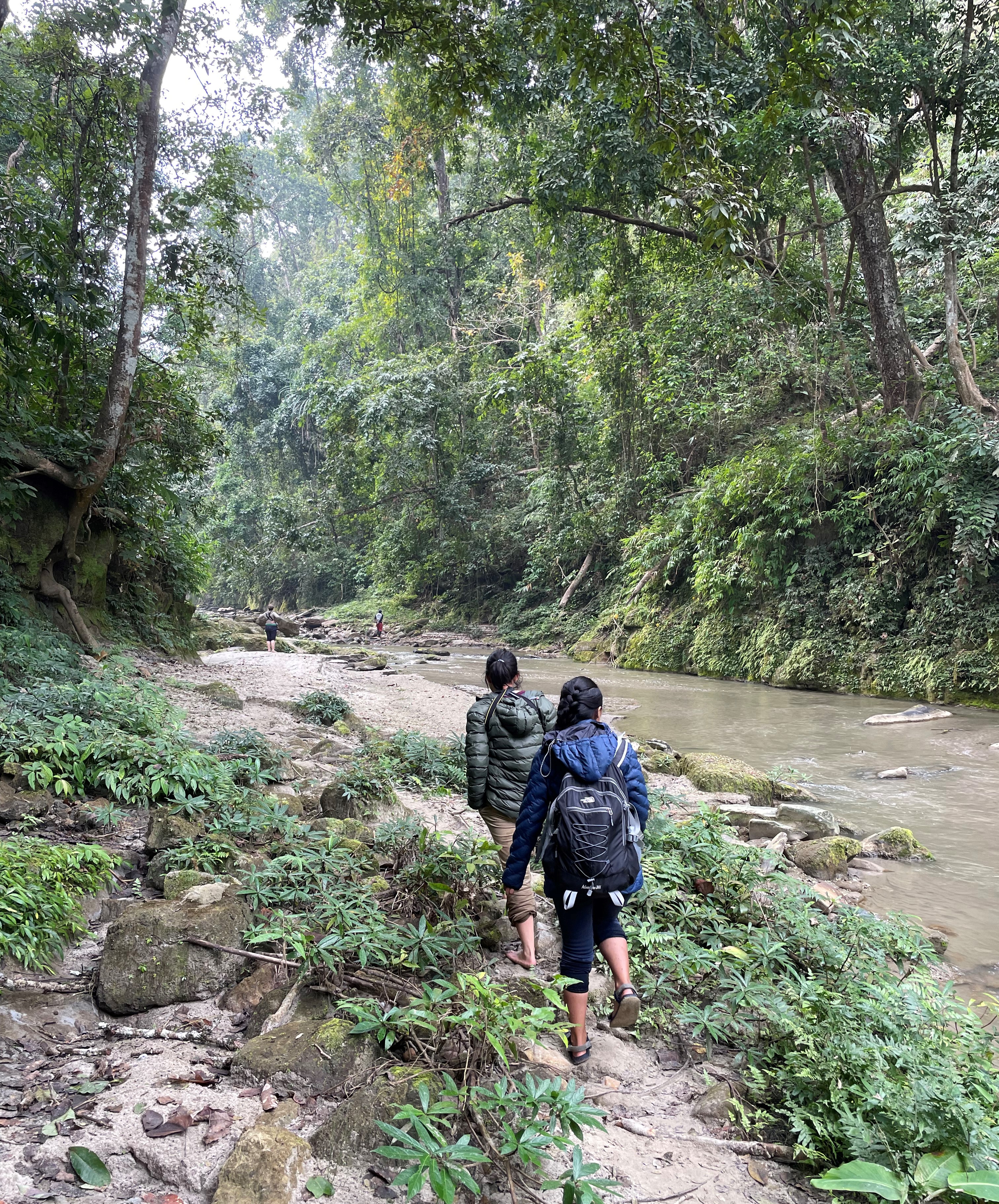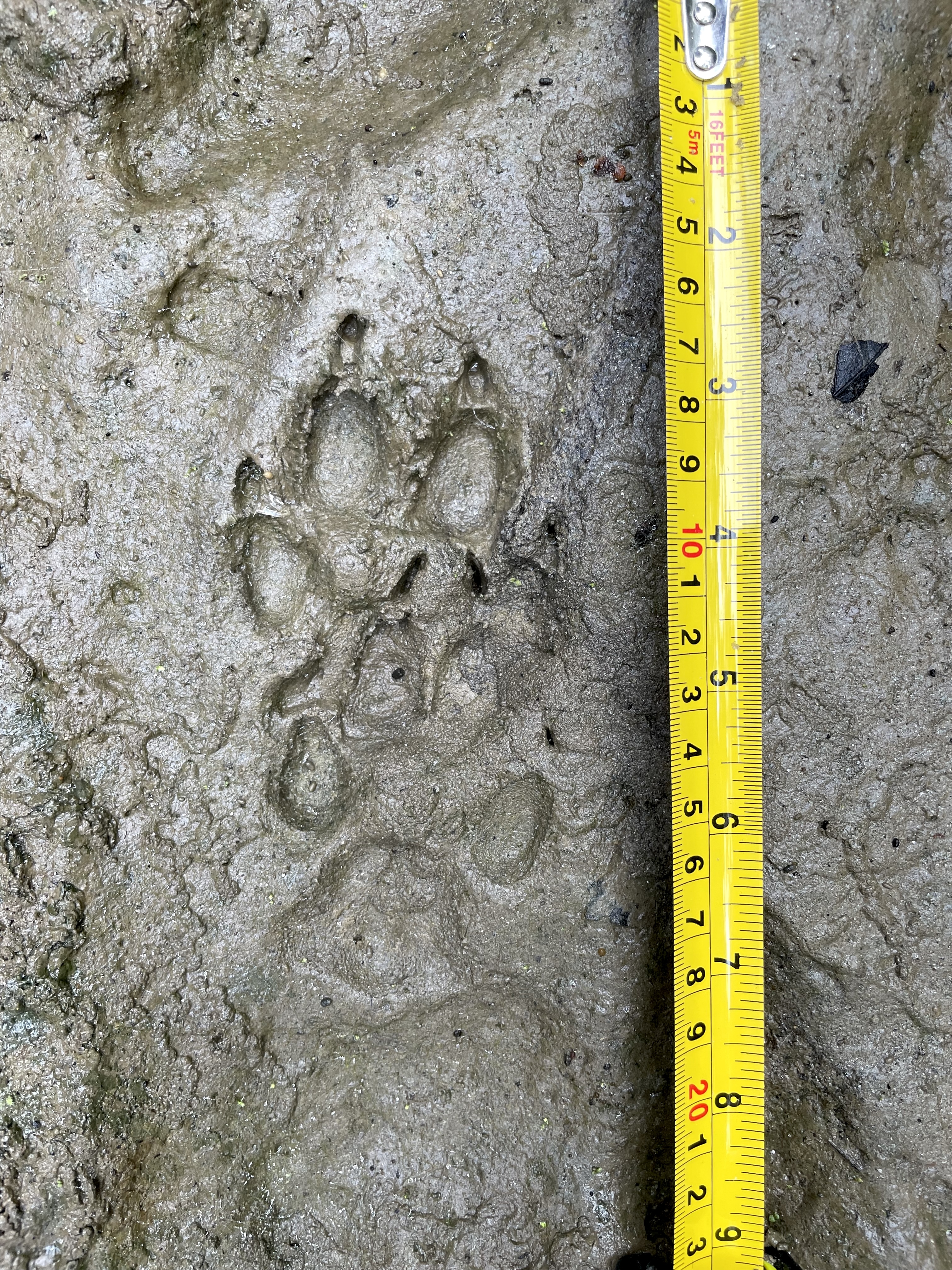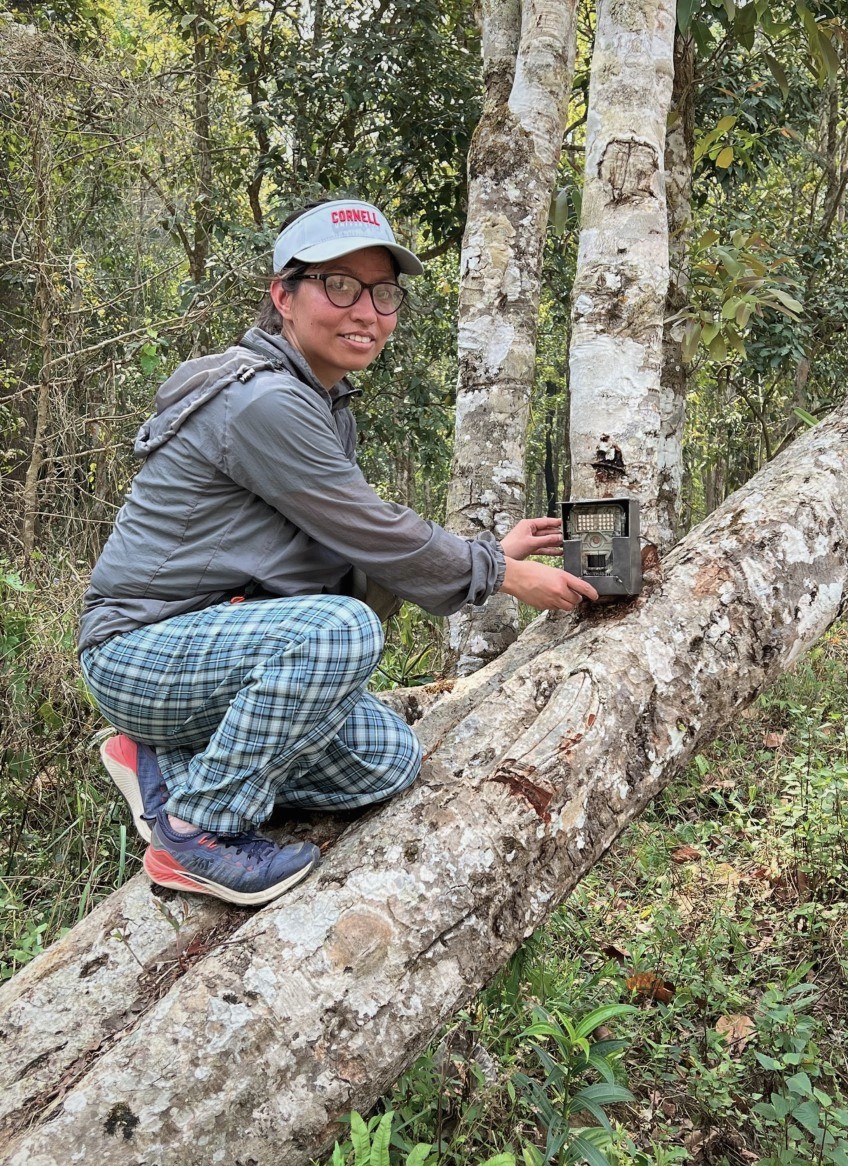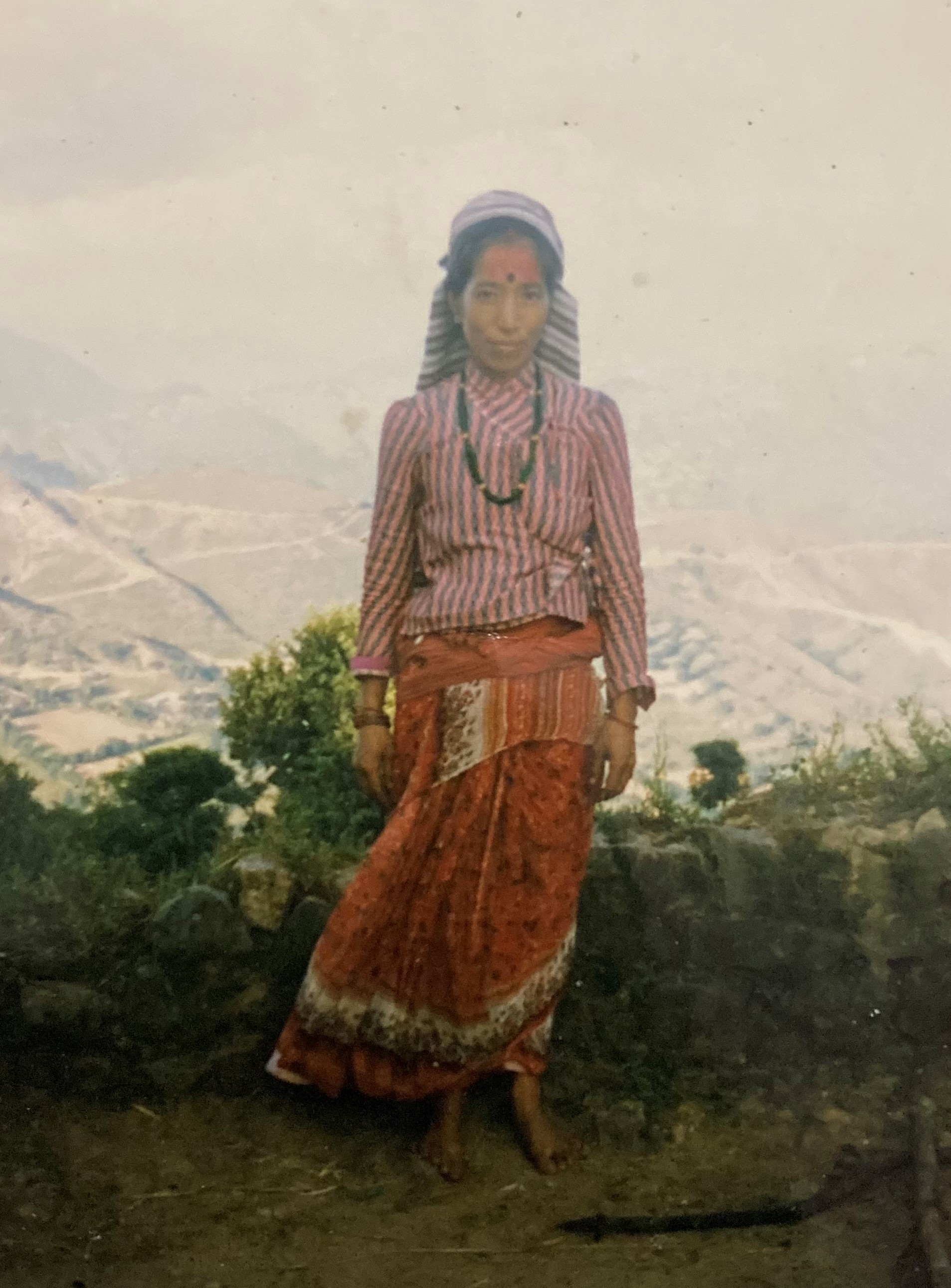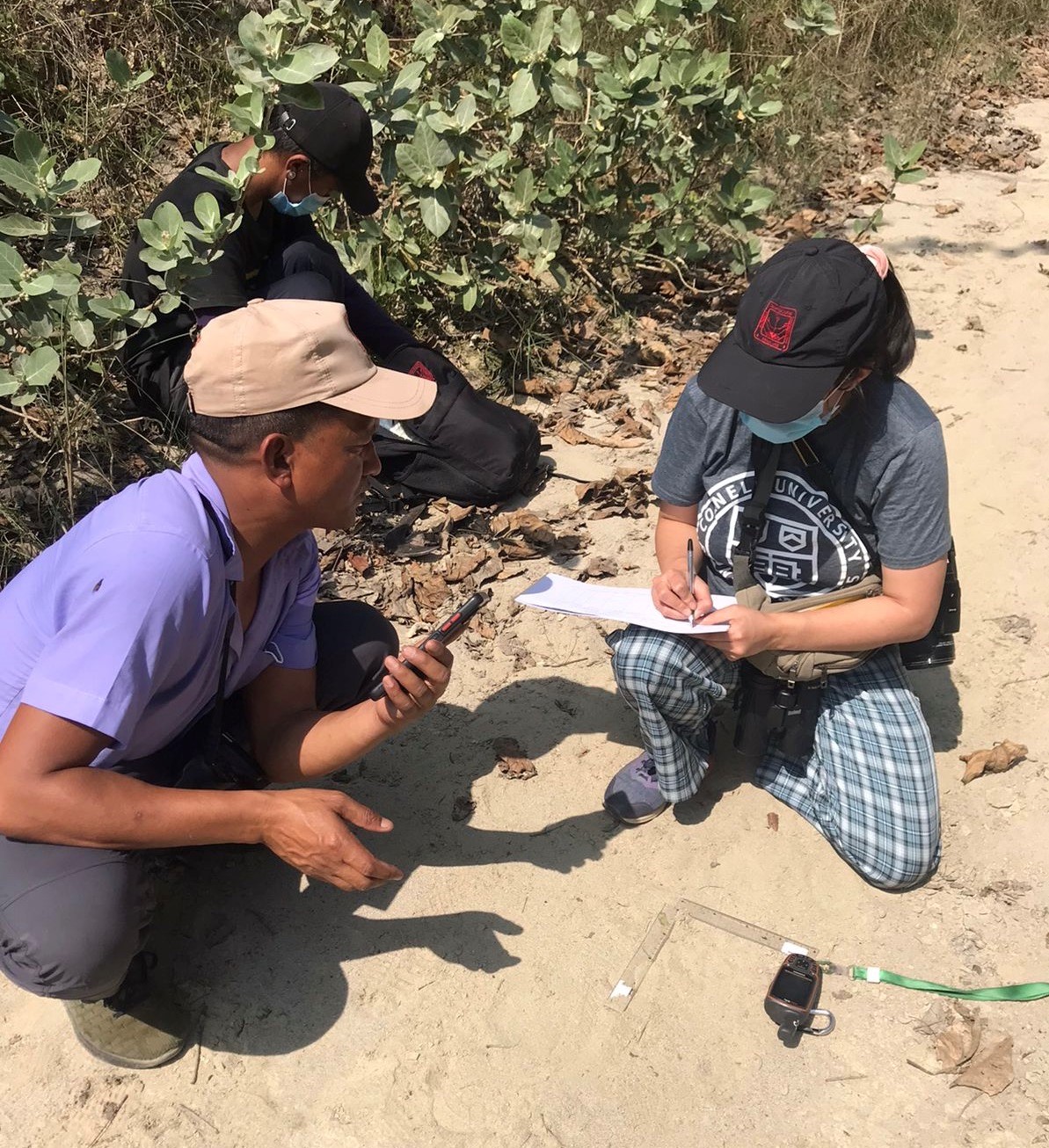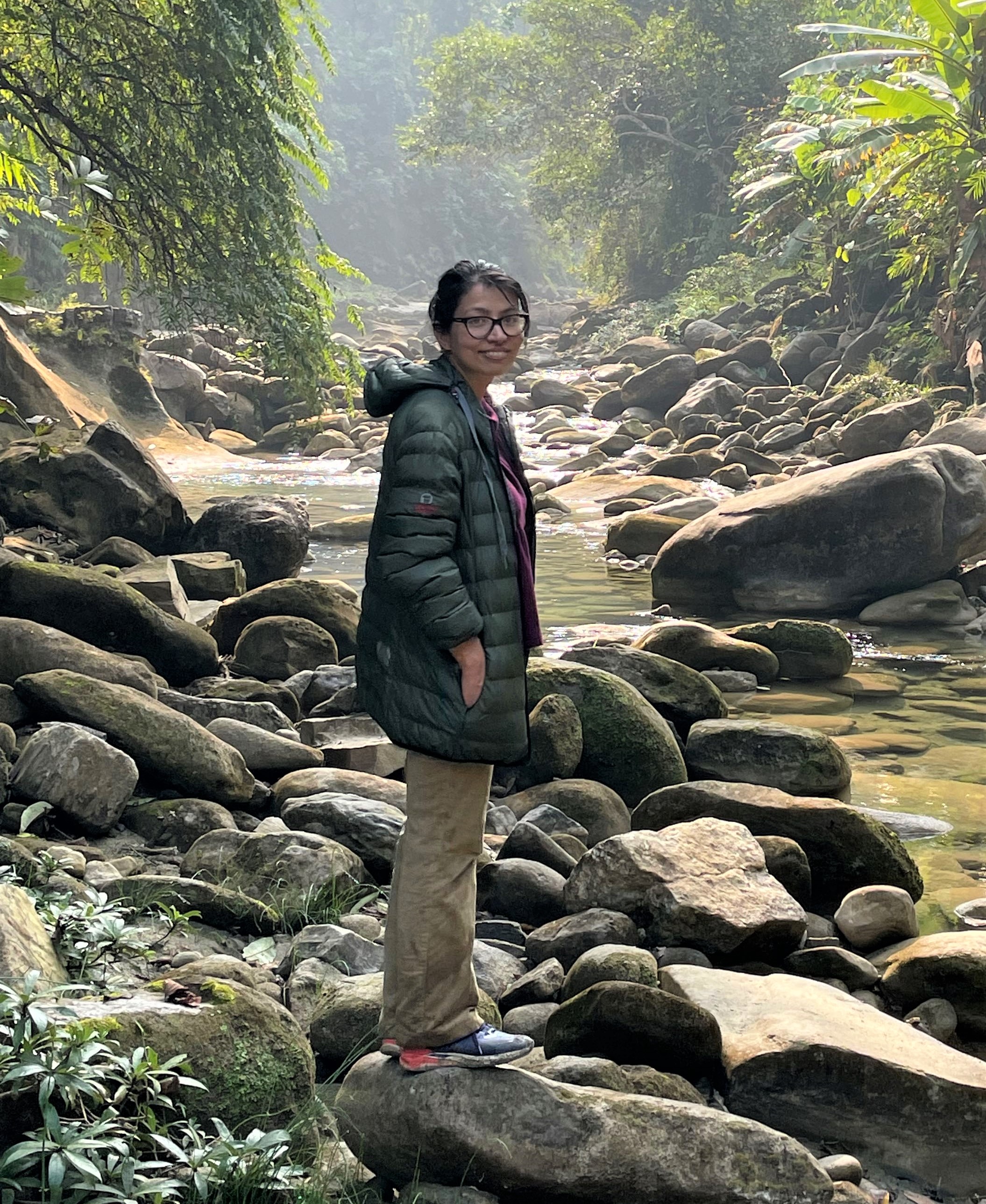Breaking Barriers and Chasing Dholes
By Trishna Rayamajhi, Cornell University College of Agriculture and Life Sciences MS Student in Natural Resources and the Environment
Six years ago, on a regular workday, I was sitting at my desk tagging photos from a camera trap survey. Late in the afternoon, a picture of an uncanny species baffled me. It looked somewhat like a domestic dog, but taller and longer-bodied. Most distinctively, the bushy black tail was dangling on its back. Upon consultation with one of the senior technicians, I learned that the animal was a 'dhole' (or bankukur in Nepali), a species I’d never heard of.
Also known as Asiatic wild dogs, dholes are one of the apex predators of tropical and subtropical forest that roam in packs and are among the most proficient hunters of all wild carnivores. Rusty brown in color, they are swift runners but are also great swimmers and, unlike other canids, they have only two molar teeth instead of three – restricting them to a pure meat diet – a specialization known as ‘hypercarnivory.’ Dholes are one of the most endangered yet least studied carnivores in the world.
The cryptic species in the photo compelled me to search for more information. Ironically, I could not find much. My initial unanswered questions brought more questions. Why did no one study them? Why aren't they brought-up in wildlife seminars and workshops?
The camera trap photo that mystified me was captured from Barandabhar Corridor Forest. The corridor forest is a key part of the Chitwan Annapurna Landscape as it connects the plain lands (Terai) with the hills and mountains (the Mahabharat and Chure Ranges), and shelters a plethora of biodiversity. In 2018, my colleagues and I published the camera trap record as the first evidence that dhole had been detected in the corridor forest). In 2019, I received a Fulbright scholarship to pursue my MS degree and chose wild dogs as my research species to analyze their occupancy and diet in Nepal. So, this field season, I am chasing dholes in Parsa National Park, the youngest national park in Nepal.
Today is the first day of installing camera traps for dholes. I wake up early before the sun. The wildlife technicians and I get ready and hop into the jeep. The jeep drops us to the closest road and thereafter we proceed on foot towards the target locations guided by our GPS (Global Positioning System). Our way is marked by fresh tracks of wild elephants and their dung. However, the excitement of sighting dholes shades the fear of encountering wild elephants or any other challenges.
As we walk down, the bright sun glares upon us. Dense sal forest with fallen, dried leaves color our way. Soon, we merge with a trail leading us to a creek. The creek appears dry as it is late March (it's hot and arid) and consists only of coarse sand and gravel meandering through the landscape. The sand absorbs the heat quickly and retains it longer, making the air hot and sticky. Soon, the waves of heat make our bare skin prickle. While walking at a brisk pace you don’t appreciate the true sensation of the heat. But as soon as you stop, you feel it rising, stinging first in the legs, moving rapidly up to the thighs and to the face, staining the cheeks. The sweat streams from your head, running down your cheeks, nose, and all over your face, streaming into the eyes, where it burns.
We keep moving toward our targeted camera trap location both with excitement and nervousness. While walking, we fixate our eyes on the trail, checking for signs of dholes and their prey. While doing so, I wonder if a dhole might be observing me and mocking my futile effort to track it down against its furtive movements! So be it; time and again I keep inspecting my surroundings with binoculars, expecting to sight the majestic swift gait of the brown creature along the stream bed. I try not to blink my eyes out of fear of missing its glance in a single flicker. But I see nothing other than swaying elephant grass and the hills on the horizon.
Dholes are adept athletes. They are rarely glimpsed and upon sighting they can vanish into the background as if they were never there.
Suddenly, my feet and eyes stop at the same time as I see some familiar tracks in the sand. So do my team members. Yes, a dhole's track! I quickly take out a ruler, GPS, datasheet, pen, and a clipboard from my bag. Measuring the footprints with the ruler, I record data and take photos of the footprints. We find additional footprints, smaller than the last ones. We speculate that it could be an adult dhole with pups.
Following the screams of peafowl and whooping screeches of monkeys and langurs, we march forward. These are alarm calls either alerting other species about us, or warning us about the predators. Soon, we reach one of our target trails. Only after deciding the best possible angle to capture images of our focal species, we set up the camera. Like humans, animals prefer the forest trail, streams, or roads to move more easily. So, we target these natural pathways. Once the camera is deployed, I record the data in my form: longitude, latitude, habitat type, and camera model number. Some of my team members seem busy patrolling in the distance with binoculars.
We keep marching to other camera locations, accompanied by the warm breeze and with the unique smell of dried sal leaves. I wonder how the burning temperature of 38-40 degrees C (100-104 F) does not daunt me; I was born and raised in the mid-hills with its mild climate. It could be the excitement due to dholes. Or could it be my tough genes? Yes, tough genes as my mom, grandmom, great grandmom, and great-great grandmom were forest users, as well as the forest keepers since time immemorial.
I visualize the blurry past where my mother spent most of her daytime hours in the forest. Carrying a doko (basket) and a namlo (long rope that supports the doko), she went into the forest every day to collect fuel for our home and fodder for our livestock. While lopping trees for fodder, she made sure each one would spring back full of life next spring, and while thinning trees she made sure that every tree got enough space, sunlight, and water to grow into a big viable tree.
My ancestors believe that ‘Bandevi’ – the goddess of the forest – resides in these wild places. The goddess is worshipped every year. If one harms the wild animals or smuggles the timber, they believe that the goddess gets angry and brings a bad omen to the family and the village. I link my ancestor’s story of safeguarding the forest with the story of dholes because both have one thing in common: both are unwritten and unheard by the world. And my quest isn’t mine alone; it’s a shared one that starts with my ancestors.
The only thing that differs is the time, the generation, and the approach.
Instead of doko and namlo, I carry a bag with my field gear (datasheets, field protocol, pens, binoculars, and camera). I study animal behavior, assess the effect of environmental factors on animals, and estimate plant and wildlife populations instead of harvesting and nurturing tree forest products. In the evening, my mother returned home with a doko full of fodder, grass and firewood but unlike her, I return back with stacks of data forms, etched with letters and numbers.
I aspire to continue this quest by training the upcoming generation of female wildlife technicians and future researchers in technical skills – like research design, fieldwork and data analysis. I am working to build a wider network and to carry-on research work on dholes, conduct regional workshops, develop guidelines for dhole conservation, and write grants for research funds from the international community to conserve this endangered species. Lesser-known dholes deserve to be well known to the whole world and become a priority species for conservation. So, I want this quest not only to go on longer, but also to grow bigger with the involvement of future generations of researchers.
With this dream I am going to take a rest now, as it was a long, long day. We walked around 35 km (22 miles) in total and installed four cameras today. The following day awaits, and will allow me to get one step closer towards a time when dholes are a genuine conservation priority.
Trishna Rayamajhi is completing her master's program with the Fuller Spatial Ecology and Decision Science Lab at Cornell University and is supervised by Dr. Angela Fuller and Dr. Martin Gilbert. Her research is funded by a Fulbright scholarship and the U.S. Geological Survey Cooperative Research Units Program.
Trishna Rayamajhi is a Fulbright scholar studying natural resources and the environment with Cornell University. Her main areas of interest are quantitative ecology and genetics. Her master's research focuses on the occupancy and diet analysis of dholes in Nepal – an endangered yet understudied species. Her study will help to uncover fundamental information about where dholes live and what species they prefer as their prey in Nepal. Trishna worked in the National Trust for Nature Conservation for three years before moving to the U.S. for her study. She completed her schooling at New Horizon Higher Secondary School and graduated from Kathmandu Forestry College. Her future plan includes exploring dhole research in Nepal, and disseminating technical and field skills she learned in the U.S. to Nepali students, particularly women.
All images, unless otherwise noted, provided by Trishna Rayamajhi.

